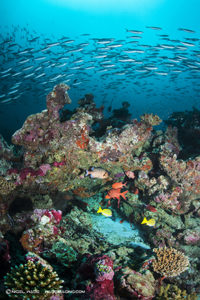Did you know..?
Five things you might not know about corals
 1. Corals are not only found in tropical waters. There is an abundance of coral species living in cold, deep water. For example, extensive deep water reef systems have been identified off the coasts of Norway and Scotland.
1. Corals are not only found in tropical waters. There is an abundance of coral species living in cold, deep water. For example, extensive deep water reef systems have been identified off the coasts of Norway and Scotland.
2. The Great Barrier Reef is the largest living structure on the planet and the only one visible from space.
3. You can tell a healthy coral reef by how loud it sounds! Reefs are noisy places, but as they get degraded, the sound begins to disappear.
4. Coral spawning (reproduction) is still a bit of a mystery. On certain nights of the year, given the right conditions (to do with the moon and water temperature), massive coral spawning events occur as individual corals release their eggs and sperm simultaneously.
5. Certain species of cold, deepwater corals are thought to be up to 8000 years old or even more, putting them among the very oldest living organisms on the planet.
Q: “If you could only dive in one place where would that place be?”
A: “Anywhere 50 years ago!”
 The words of Sylvia Earle, legendary explorer and spokeswoman for the oceans.
The words of Sylvia Earle, legendary explorer and spokeswoman for the oceans.
Listen to people who have lived around and dived on coral reefs for decades, not only scientists and researchers but also those who make a living from them through fishing or tourism, and you will often hear similar stories of how much the underwater environment has changed. In just a few decades, many reefs are no more than a shadow of their former selves, with only a tiny percentage of the numbers of fish and other species which once populated them.
Colourful hard and soft corals covered reefs which teemed with huge shoals of fish, large predators such as sharks, turtles, rays and other pelagics and small bottom dwelling lobsters, crabs, triton shells and thousands more species. Today, to dive in those same spots is to bear witness to an accelerating ecological catastrophe. The size and quantity of fish has plummeted, many corals which can take hundreds of years to develop and grow are reduced to colourless rubble, covered with algae, while the reef’s large ocean visitors such as sharks and manta rays are no longer regular visitors.
Humans have contributed in myriad ways to this decline: overfishing, destructive fishing practices such as dynamite or cyanide fishing and bottom-trawling, vast quantities of industrial and agricultural runoff polluting vast tracts of coast, oil spills, filling the oceans with plastic and microbeads and harmful chemicals from everyday products such as sunscreen.
